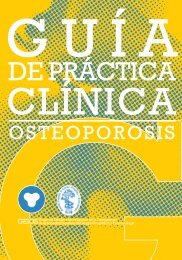guia_fractura_cadera
guia_fractura_cadera
guia_fractura_cadera
You also want an ePaper? Increase the reach of your titles
YUMPU automatically turns print PDFs into web optimized ePapers that Google loves.
Guía de buena práctica clínica en Geriatría. FRACTURA DE CADERA<br />
natos producen beneficio en la prevención de <strong>fractura</strong>s vertebrales y en<br />
cambio no producen en <strong>fractura</strong>s no vertebrales, incluida la <strong>fractura</strong> de <strong>cadera</strong>,<br />
y es necesaria una cuidadosa evaluación individualizada en estos casos 11,33 .<br />
Sí hay estudios, aunque escasos, en mujeres mayores de 80 años que<br />
aportan datos positivos en la prevención de <strong>fractura</strong> de <strong>cadera</strong> con calcio y<br />
vitamina D y con el ranelato de estroncio 20,37 .<br />
— La eficacia de los fármacos antirresortivos es menor si no se garantiza una<br />
ingesta adecuada de calcio y vitamina D, que asegure unos valores normales<br />
en sangre; por ello, muchas veces es necesario evaluar si existe déficit y<br />
dar suplementos de calcio y vitamina D si fuera necesario. Además, en diversos<br />
estudios se demuestra mayor eficiencia del calcio y vitamina D respecto<br />
a los bifosfonatos en relación a un menor coste para evitar una <strong>fractura</strong> 39 .<br />
— Tradicionalmente, la osteoporosis primaria se ha clasificado en 2 entidades<br />
definidas: perimenopáusica y senil. Ambas difieren en la fisiopatología,<br />
manifestaciones clínicas y tratamiento. Los avances científicos recientes en<br />
fisiopatología y tratamiento demuestran que la osteoporosis senil es una<br />
entidad asociada al envejecimiento que precisa un enfoque particular 40 .<br />
BIBLIOGRAFÍA<br />
1. Cummings SR, Nevitt MC, Browner WS, Stone K, Fox KM, Ensrud KE, et al. Risk factors for hip<br />
fracture in white women. Study of Osteoporotic Fractures Research Group. N Engl J Med.<br />
1995;332:767-73.<br />
2. Pluijm SMF, Graafmans WC, Bouter LM, Lips P. Ultrasound measurements for the prediction of<br />
osteoporotic fractures in elderly people. Osteoporosis Int. 1999;9:550-6.<br />
3. Taylor BC, Schreiner PJ, Stone KL, Fink HA, Cummings SR, Nevitt MC, et al. Long-term prediction<br />
of incident hip fracture risk in elderly white women: osteoporotic fractures. J Am Geriatr<br />
Soc. 2004;52:1479-86.<br />
4. Cummings SR, Black DM, Nevitt MC, Browner W, Cauley J, Ensrud K, et al. Bone density at<br />
various sites for prediction of hip fractures. The Study of Osteoporotic Fractures Research.<br />
Group. Lancet 1993;341:72-5.<br />
5. Fiechtner JJ. Hip fracture prevention drug therapies and life style modifications that can reduce<br />
risk. Postgrad Med. 2003;114:22-32.<br />
6. Marshall D, Johnell O, Wedel H. Meta-analysis of how well measures of bone mineral density<br />
predict occurrence of osteoporotic fractures. Br Med J 1996;312:1254-9.<br />
7. Tinetti ME, Baker DI, McAvay G, et al. A mutifactorial intervention to reduce the risk of falling<br />
among elderly people living in the community. N Engl J Med. 1994;331:821-7.<br />
100



